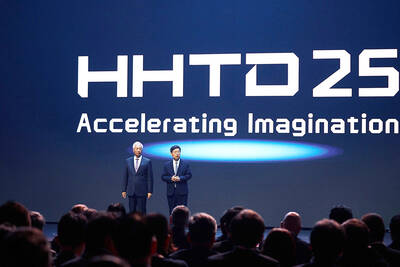Minister of Economic Affairs Shen Jong-chin (沈榮津) yesterday urged offshore wind energy companies to improve their communication with the public to dispel doubts about the renewable technology amid growing disappointment among some developers.
Six offshore wind projects developed by Orsted A/S, Hai Long Offshore Wind (海龍), a joint venture by Northland Power Inc and Yushan Energy Co (玉山能源), Copenhagen Infrastructure Partners and China Steel Corp (中鋼) missed Wednesday’s deadline to secure power purchase agreements at last year’s feed-in tariff (FIT) rate of NT$5.8498 per kilowatt-hour as a proposed cut to NT$5.106 for the next 20 year looms.
All stakeholders of offshore wind projects must help in combating the smear campaign against offshore wind energy waged by detractors of the renewable energy, Shen told reporters following a meeting with developers.
Critics have continued to paint offshore wind energy as expensive and unreliable, and claim that the government’s perceivably generous purchasing price would become a tremendous burden for Taiwan.
Orsted, which is working to add 900 megawatts to the power grid by 2021 through its projects in Changhua County, has announced that it would revisit its investment activities in Taiwan in the coming weeks.
The company needs to see a drastic change in the government’s offshore wind policies before further expansions in its Changhua County projects can proceed, Orsted chief executive officer Martin Neubert said.
“I understand that there are some hard feelings over the government’s decision and continued communication between all parties is the way forward,” Shen said, calling the meeting helpful.
The meeting came after a public hearing last month in which developers were told to submit further evidence supporting their case against an FIT rate cut.
Shen said that the meeting did not discuss revisions to the FIT rate, and other hot issues that could impact project financing and lenders’ confidence, such as the introduction of a yearly cap of 3,600 operating hours on power purchases as well as a tiered FIT scheme.
While an impasse between the central and Changhua County governments was seen as a major obstacle in the developers’ bid to gain establishment permits and finalize power purchasing prices, Shen said that administrative efficiency would be improved as misgivings are removed through communication.
During the meeting, Shen reiterated that offshore wind energy remains an important aspect of the central government’s drive toward energy diversification and renewables.
He said that developers were receptive to the message and would inform their head offices and shareholders.
Taiwan’s offshore wind sector is still in its infancy, Shen said, urging developers to remember the same difficulties they had faced when the first projects were installed in Europe more than two decades ago.
The county government has just witnessed a handover of power and the new administration under the Chinese Nationalist Party (KMT) needs time to settle in, he said.
He suggested that Copenhagen Infrastructure Partners screen some of its documentary films in Changhua County on how offshore wind projects had boosted economy in Denmark.

Shiina Ito has had fewer Chinese customers at her Tokyo jewelry shop since Beijing issued a travel warning in the wake of a diplomatic spat, but she said she was not concerned. A souring of Tokyo-Beijing relations this month, following remarks by Japanese Prime Minister Sanae Takaichi about Taiwan, has fueled concerns about the impact on the ritzy boutiques, noodle joints and hotels where holidaymakers spend their cash. However, businesses in Tokyo largely shrugged off any anxiety. “Since there are fewer Chinese customers, it’s become a bit easier for Japanese shoppers to visit, so our sales haven’t really dropped,” Ito

The number of Taiwanese working in the US rose to a record high of 137,000 last year, driven largely by Taiwan Semiconductor Manufacturing Co’s (TSMC, 台積電) rapid overseas expansion, according to government data released yesterday. A total of 666,000 Taiwanese nationals were employed abroad last year, an increase of 45,000 from 2023 and the highest level since the COVID-19 pandemic, data from the Directorate-General of Budget, Accounting and Statistics (DGBAS) showed. Overseas employment had steadily increased between 2009 and 2019, peaking at 739,000, before plunging to 319,000 in 2021 amid US-China trade tensions, global supply chain shifts, reshoring by Taiwanese companies and

Taiwan Semiconductor Manufacturing Co (TSMC) Chairman C.C. Wei (魏哲家) and the company’s former chairman, Mark Liu (劉德音), both received the Robert N. Noyce Award -- the semiconductor industry’s highest honor -- in San Jose, California, on Thursday (local time). Speaking at the award event, Liu, who retired last year, expressed gratitude to his wife, his dissertation advisor at the University of California, Berkeley, his supervisors at AT&T Bell Laboratories -- where he worked on optical fiber communication systems before joining TSMC, TSMC partners, and industry colleagues. Liu said that working alongside TSMC

TECHNOLOGY DAY: The Taiwanese firm is also setting up a joint venture with Alphabet Inc on robots and plans to establish a firm in Japan to produce Model A EVs Manufacturing giant Hon Hai Precision Industry Co (鴻海精密) yesterday announced a collaboration with ChatGPT developer OpenAI to build next-generation artificial intelligence (AI) infrastructure and strengthen its local supply chain in the US to accelerate the deployment of advanced AI systems. Building such an infrastructure in the US is crucial for strengthening local supply chains and supporting the US in maintaining its leading position in the AI domain, Hon Hai said in a statement. Through the collaboration, OpenAI would share its insights into emerging hardware needs in the AI industry with Hon Hai to support the company’s design and development work, as well